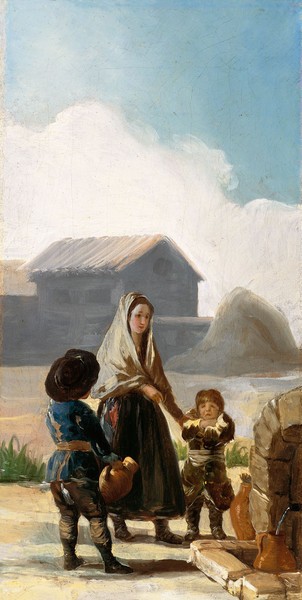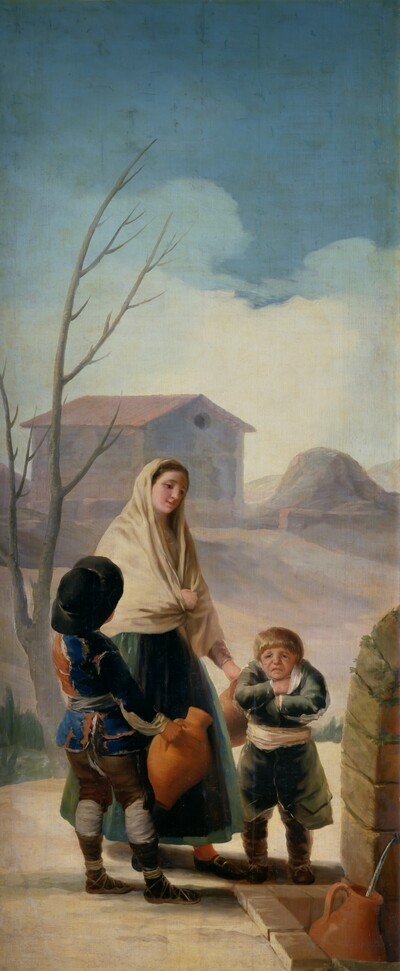- Cronología
- 1786
- Ubicación
- Museum Thyssen-Bornemisza, Madrid, Spain
- Dimensiones
- 35.5 x 18.5 cm
- Técnica y soporte
- Oil on canvas
- Reconocimiento de la autoría de Goya
- Documented work
- Titular
- Colección Privada Thyssen
- Ficha: realización/revisión
- 14 Dec 2009 / 14 Jun 2023
- Inventario
- (CTB.1983.38) e
- Otros títulos:
-
A Woman and Two Children next to a Fountain (Una mujer y dos niños junto a una fuente)
Sketch for the tapestry cartoon Poor Children at the Well.
This sketch was made by Goya in autumn 1786, to be shown to the king for his approval. This meeting probably took place on 1 May 1787, the date recorded for the payment of a carriage to take the artist to the palace of El Escorial so that he might show the king the sketches for the dining-room piece for El Pardo.
The artist may have kept the sketch himself, which was later to appear in the collection of the Duke and Duchess of Osuna. However, it does not appear in the payment order of 1799 for the sketches made by Goya and sold to the Duke and Duchess a year earlier, and as such we can deduce that it may have been given as a gift at some undetermined subsequent date. It remained in the collection of the Duke and Duchess of Osuna until its sale in 1896, at the time of the bankruptcy of the ducal household and by order of the executive bondholder board, when it came to form part of the Lafora collection in Madrid, having been acquired for the sum of 1,000 pesetas.
Afterwards it belonged to the collection of the Duke of Valencia and was then subsequently found in the collections of Mercedes de Borbón, Carlos de Borbón, and Alfonso Ferrer, ending up, in 1960, in the collection of P. & D. Colnaghi, in London. Later in was in a private collection in Herefordshire, England, from where, in 1987, it went to that of E. V. Thaw, in New York, where it remained until entering the collection where it is found today.
The sketch features some differences compared to the cartoon, which are of great help in understanding Goya's original idea. In the cartoon we can see certain additions made to increase the feeling of wintertime, such as for example the bare tree, the leaden sky replacing the blue sky of the sketch, and the snowy background, all of which make clear references to winter. Even the foliage growing behind the figures is painted in a less intense green.
In the sketch, on the other hand, there is nothing to suggest that this is a winter scene: the child on the right who appears to be shivering with cold in the cartoon is here angry because, unlike his older brother, he has not been entrusted with the task of carrying a pitcher, and their mother encourages him to take the one that is filling in the fountain. There is nothing to suggest that the figures are poor, either. It was Cruzada Villaamil who incorrectly gave the cartoon the title of Los pobres, The Poor, in his work of 1870. In the finished painting, the woman wears shoes with buckles, thus confirming that this is a relatively well-off family.
The sketch is executed delicately, with particular care being paid to the rendering of the figures, including details such as the highlights and fringing on their clothes, and the expressions on their faces.
-
Exposición y venta de los cuadros, esculturas, grabados y otros objetos artísticos de la Casa DucaPalacio de la Industria y de las ArtesMadrid18961896cat. 81
-
Exposición histórico-artística del Centenario del Dos de MayoMuseo Arqueológico NacionalMadrid1908cat. 3661
-
GoyaKoninklijk Kabinet van Schilderijen MauritshuisThe Hauge1970organized by Ministerio de Estado y Asuntos Culturales and Réunion des Musées Nationaux, July 4th to September 13th 1970. Exhibited also at the Musée de l’Orangerie des Tuileries, Paris, October 25th to December 7th 1970, consultant editors Jeannine Baticle and A. B. de Vriescat. 9
-
Goya. El Capricho y la Invención. Cuadros de gabinete, bocetos y miniaturasMuseo Nacional del PradoMadrid1993from November 18th 1993 to February 15th 1994. Exhibited also at the Royal Academy of Arts, London, March 18th to June 12th 1994 and The Art Institute of Chicago, Chicago, July 16th to October 16th 1994, consultant editors Manuela B. Mena Marqués and Juliet Wilson-Bareaucat. 23
-
Goya: Prophet der ModerneAlte NationalgalerieBerlin2005from July 13th to October 3th 2005. Exhibitied also at the Kunsthistorischemuseum, Vienna, October 18th 2005 to January 8th 2006, consultant editor Manuela B. Mena Marquéscat. 16
-
Agen2019cat. 4
-
L'œuvre peint de Goya. 4 volsParís1928-1950vol. I, p. 190, cat. 149
-
Tapices de GoyaMadridPatrimonio Nacional1946p. 257, cat. 45ª
-
Vie et ouvre de Francisco de GoyaParísOffice du livre1970pp. 79, 97, cat. 261
-
BarcelonaPolígrafa1970vol. I, p. 268, cat. 222
-
L’opera pittorica completa di GoyaMilanRizzoli1974p. 102, cat. 204
-
Francisco de Goya, 4 vols.ZaragozaCaja de Ahorros de Zaragoza, Aragón y Rioja1980-1982vol. II, p. 43
-
Francisco de Goya, cartones y tapicescol. col. "Espasa Arte"Espasa Calpe1987pp. 147, 184 194, cat. 49B
-
Goya. El capricho y la invención. Cuadros de gabinete, bocetos y miniaturasMadridMuseo del Prado1993p. 168, cat. 23 y p. 169 (il.)
-
AgenSnoeck2019pp. 106-107

